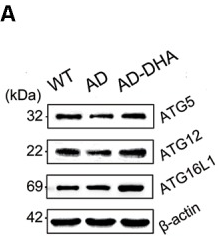ATG12 Antibody - #DF7937
| 製品: | ATG12 Antibody |
| カタログ: | DF7937 |
| タンパク質の説明: | Rabbit polyclonal antibody to ATG12 |
| アプリケーション: | WB IHC |
| Cited expt.: | WB |
| 反応性: | Human, Mouse, Rat |
| 予測: | Pig, Zebrafish, Bovine, Horse, Sheep, Dog, Chicken, Xenopus |
| 分子量: | 22 kDa; 15kD(Calculated). |
| ユニプロット: | O94817 |
| RRID: | AB_2841346 |
製品説明
*The optimal dilutions should be determined by the end user. For optimal experimental results, antibody reuse is not recommended.
*Tips:
WB: For western blot detection of denatured protein samples. IHC: For immunohistochemical detection of paraffin sections (IHC-p) or frozen sections (IHC-f) of tissue samples. IF/ICC: For immunofluorescence detection of cell samples. ELISA(peptide): For ELISA detection of antigenic peptide.
引用形式: Affinity Biosciences Cat# DF7937, RRID:AB_2841346.
折りたたみ/展開
APG12-like; APG12L; ATG12; ATG12 autophagy related 12 homolog (S. cerevisiae); ATG12 autophagy related 12 homolog; ATG12_HUMAN; Autophagy 12; Autophagy-related protein 12; FBR93; HAPG12; Ubiquitin-like protein ATG12;
免疫原
A synthesized peptide derived from human ATG12, corresponding to a region within the internal amino acids.
- O94817 ATG12_HUMAN:
- Protein BLAST With
- NCBI/
- ExPASy/
- Uniprot
MAEEPQSVLQLPTSIAAGGEGLTDVSPETTTPEPPSSAAVSPGTEEPAGDTKKKIDILLKAVGDTPIMKTKKWAVERTRTIQGLIDFIKKFLKLVASEQLFIYVNQSFAPSPDQEVGTLYECFGSDGKLVLHYCKSQAWG
種類予測
Score>80(red) has high confidence and is suggested to be used for WB detection. *The prediction model is mainly based on the alignment of immunogen sequences, the results are for reference only, not as the basis of quality assurance.
High(score>80) Medium(80>score>50) Low(score<50) No confidence
研究背景
Ubiquitin-like protein involved in autophagy vesicles formation. Conjugation with ATG5 through a ubiquitin-like conjugating system involving also ATG7 as an E1-like activating enzyme and ATG10 as an E2-like conjugating enzyme, is essential for its function. The ATG12-ATG5 conjugate acts as an E3-like enzyme which is required for lipidation of ATG8 family proteins and their association to the vesicle membranes.
(Microbial infection) May act as a proviral factor. In association with ATG5, negatively regulates the innate antiviral immune response by impairing the type I IFN production pathway upon vesicular stomatitis virus (VSV) infection. Required for the translation of incoming hepatitis C virus (HCV) RNA and, thereby, for the initiation of HCV replication, but not required once infection is established.
Acetylated by EP300.
Cytoplasm. Preautophagosomal structure membrane>Peripheral membrane protein.
Note: TECPR1 recruits the ATG12-ATG5 conjugate to the autolysosomal membrane.
Ubiquitous.
Shares weak sequence similarity with ubiquitin family, but contains an 'ubiquitin superfold' and the C-terminal Gly is required for isopeptide linkage.
Belongs to the ATG12 family.
研究領域
· Cellular Processes > Transport and catabolism > Autophagy - other. (View pathway)
· Cellular Processes > Transport and catabolism > Autophagy - animal. (View pathway)
· Environmental Information Processing > Signal transduction > FoxO signaling pathway. (View pathway)
· Organismal Systems > Immune system > NOD-like receptor signaling pathway. (View pathway)
· Organismal Systems > Immune system > RIG-I-like receptor signaling pathway. (View pathway)
参考文献
Application: WB Species: Mouse Sample: brain tissue
Application: WB Species: Rat Sample: cartilage tissue
Restrictive clause
Affinity Biosciences tests all products strictly. Citations are provided as a resource for additional applications that have not been validated by Affinity Biosciences. Please choose the appropriate format for each application and consult Materials and Methods sections for additional details about the use of any product in these publications.
For Research Use Only.
Not for use in diagnostic or therapeutic procedures. Not for resale. Not for distribution without written consent. Affinity Biosciences will not be held responsible for patent infringement or other violations that may occur with the use of our products. Affinity Biosciences, Affinity Biosciences Logo and all other trademarks are the property of Affinity Biosciences LTD.




